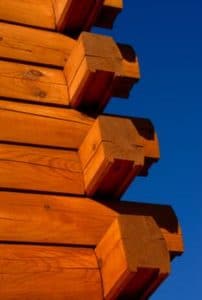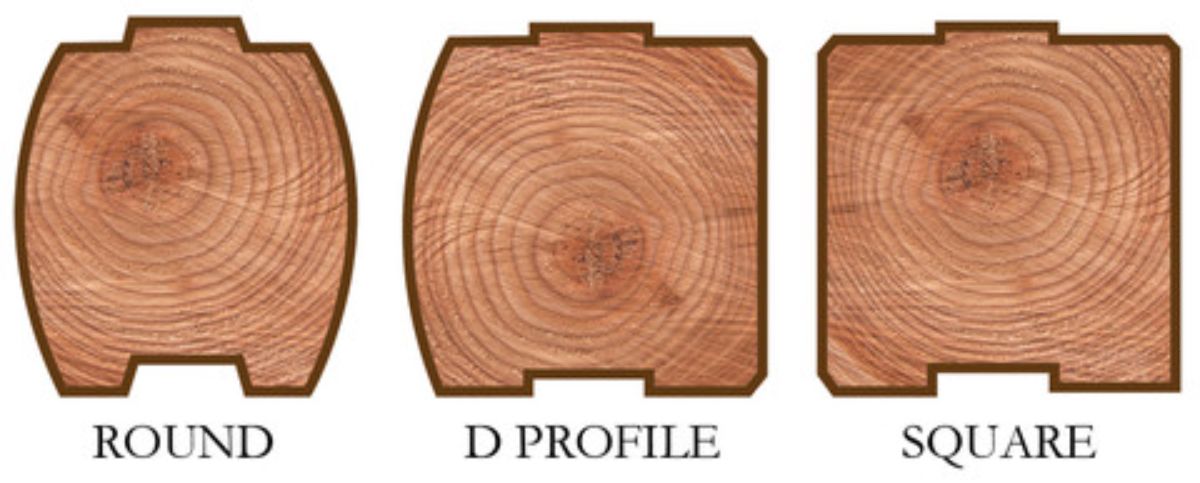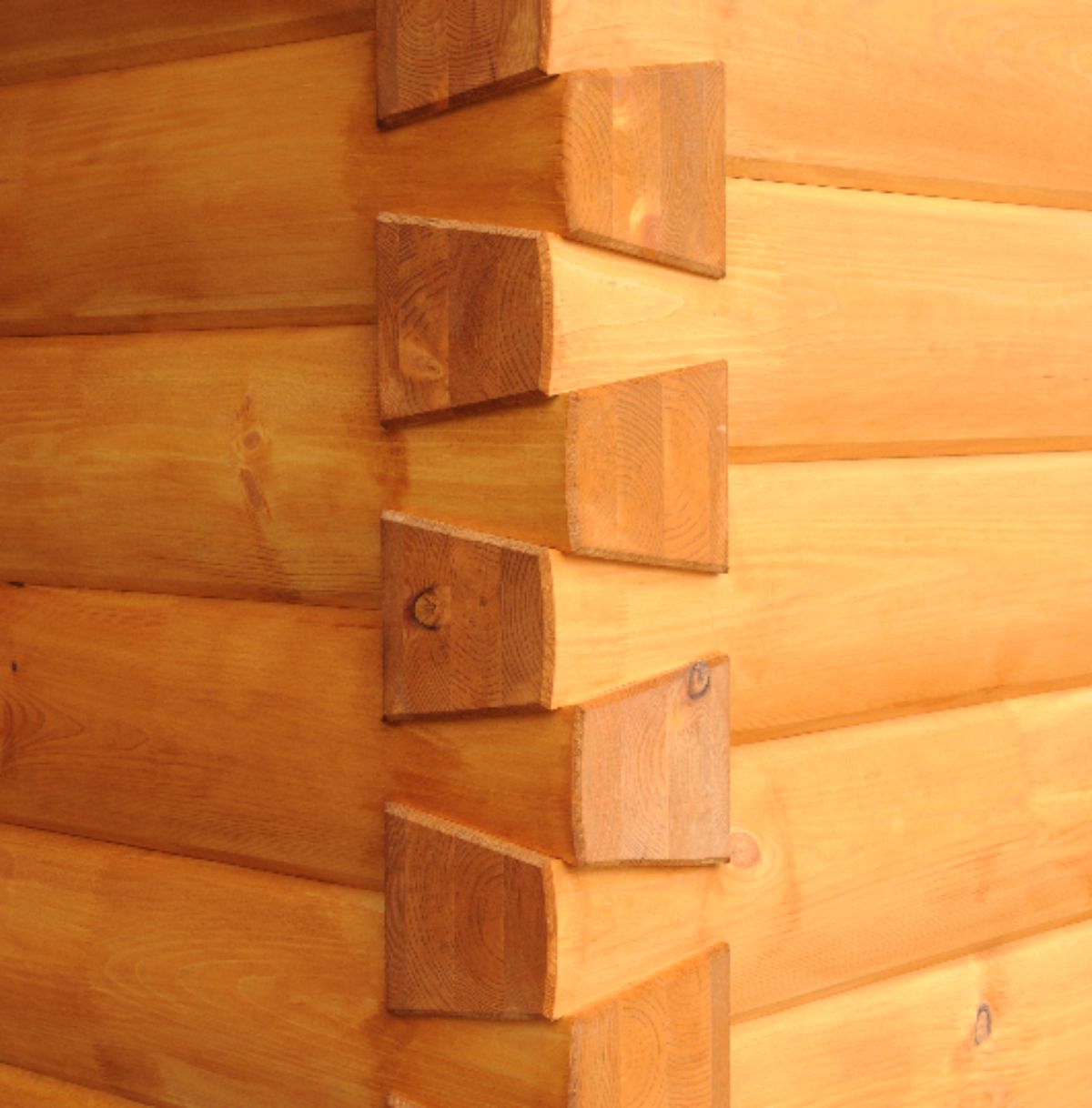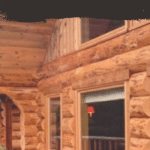Milled logs or handcrafted logs - these are two primary distinctions when it comes to log homes. The difference is just what it sounds like: handcrafted logs are cut and peeled by hand with a drawknife or water-peeled and are natural, rougher, and more uneven in appearance.
Jump to:

These shaped logs have been through a wood mill or planer and are smooth and uniform, easier to work with and faster to assemble. For that reason, milled logs are the most popular option for log home kits and for homeowners building their own log cabins.
Milled logs are cut into a specific profile or shape. For example, log styles can be round, square, or D-shaped. The D-shape is popular because the rounded outer face gives the natural appearance of logs, while the flat inner face makes hanging pictures and cabinets easier and doesn’t hold dust like a round log might.
Bear in mind that you must use special consideration when attaching ledger boards for porches and decks to a round log.
What Kind of Wood is best?
Although many different species of wood are used in building log homes, the most common are the softer woods, such as pine, fir, spruce, and cedar. The best wood to use is typically whatever wood is commonly available at your cabin’s location. That wood will be suitable for the local weather and readily available at a lower price than shipping in wood from somewhere else.
Fitting It All Together
One of the best reasons to use milled logs is because they have a profile designed to fit together smoothly which helps provide an energy efficient log home. It’s easy to see how the logs interlock and match top and bottom, with insulation, caulking cord, or log caulking in between to eliminate air infiltration. The tops and bottoms may be coped, smooth or tongue-and-groove.

Milled logs are sold by the linear foot, typically in lengths ranging from 8-feet to 16-feet. Logs longer than 16-feet are heavy and difficult to move. Walls are generally broken up into shorter-length logs between doors and windows anyway.
When longer spans are needed you can break them up at an intervening wall or butt them together to span the entire wall.
Buying your logs from a mill or log supplier has many benefits:
- They are much cheaper than log home kits
- They can provide custom sizes, shapes and even dovetail corners
- You can choose your own builder and save more money
- You can buy what you need, when you need it
- Delivery is reasonable, or even free within a certain area
- You have the flexibility of making on-site modifications to your log home floorplans
- You can get graded logs that adhere to log standards developed by the International Code Council
Green, Air Dry, Kiln Dry, Standing Dry

Green logs are normally winter-cut, during the fall and winter. This is when the sap is dormant and moisture at a minimum. It also means the wood is free of insects and disease. The wood is heavy, due to the high moisture content, and is prone to shrinkage and possibly warping as it dries out.
Air-dried wood is wood that has been set out to dry, often in a drying shed protected from the weather, for varying lengths of time. The logs are stickered, meaning that small lengths of wood are inserted between logs to separate them and allow maximum air circulation. Air drying is the hardest to control as drying times vary so much.
Kiln-dried logs have been run through a heated kiln to speed up the drying process and typically have more closely controlled moisture levels, allowing for more accurate predictions of their final size and they also have minimal shrinkage.
Standing dry logs are logs cut from trees that have been killed by disease, fire or insects but have never been cut. They have not been sheltered from the rain, obviously, but being vertical, they are generally very dry. They can have checking due to the uneven drying and are often sap-stained.
Calculating Linear Feet of Milled Logs
Mills and log suppliers sell log by linear feet. This means you are ordering and paying by the total length of logs needed. By the way, “linear” is the correct term to use to designate length (as opposed to square feet or cubic feet). Some people use the term “lineal” but this is incorrect since lineal refers to ancestry.
To determine the correct number of linear feet needed for your log home you need to calculate the number of courses required to achieve your desired wall height, then multiply that by the length of that wall.
Let’s work an example.
You’re using 6” x 8” D-logs that have a finished height of 8” to build a 10-foot-high wall, 24-feet long:
- Each log only adds 8” / 12” to the height, or 0.67 foot.
- 10 feet / 0.67’ means it will take 14.9 courses to attain 10 feet in height. Round that up to 15 courses.
- Since the wall is 24-feet long, you will need 24 x 15 = 360 linear feet of 6” x 8” logs.
- From this number you can subtract the area that will be cut out for doors and windows using the same process: If you have a 3’ x 8’ door, that’s 3’ x (8’ / 0.67) = 24 linear feet.
- You also need to add in for any overhangs at the corners and an additional amount for waste, typically 10%, although you can go less with care.
Choosing milled logs from a mill or log supplier will save you money over buying a log cabin kit and it will provide an energy-efficient, easy-to-assemble alternative that gives you the maximum flexibility in design. Log suppliers and mills are used to dealing with log home builders and can give you guidance and assistance with your order.
More Log Home Design Pages:
REScheck: Tricks of the Trade REScheck is software designed to compute an energy compliance analysis that is needed for building permit applications.
Log Cabin Design Tips Tips for your log cabin design that will save you money.
Aging In Place Ideas for Your Log Cabin As people become older, remaining in their own home becomes more important and aging in place design can facilitate that.
Log Cabin Home Design – Evaluating All the Factors The ideal log cabin home design is different for everybody and must be determined after evaluating all the factors involved.
Tips for Building Stairs These tips for building stairs will make quick work of your design.


Randy Eubanks
I’m going to build a woodworking shop and wanting a log structure.
Their will be no interior rooms. 20x20 or 20x30.
Can you advise on your product.
Thanks Randy
Madisonville Ky.